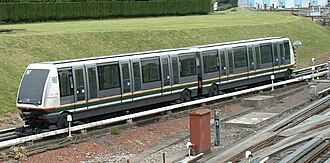Automated guideway transit





Automated Guideway Transit (AGT) is a type of public transportation system that features automated, driverless vehicles operating on guideways. AGT systems are designed to provide high-capacity, efficient, and reliable transport in urban areas, airports, and at theme parks. These systems are characterized by their use of dedicated tracks, which can be either elevated or at ground level, ensuring that they do not interfere with pedestrian or vehicular traffic.
Overview[edit]
Automated Guideway Transit systems vary in terms of the technology used, the capacity of vehicles, and the distance covered. Common types of AGT include people movers, light metro systems, and monorails. These systems are powered by electricity and are controlled by sophisticated computer systems that manage vehicle operation, navigation, and scheduling.
History[edit]
The concept of AGT emerged in the early 20th century, but significant development and implementation occurred in the late 1960s and early 1970s. The aim was to create a transport system that could operate independently of human control, reduce congestion in urban centers, and provide a cost-effective alternative to traditional public transport systems.
Technology[edit]
AGT systems employ various technologies to ensure safe and efficient operation. These include automated control systems, real-time monitoring, and advanced safety features. Vehicles are typically guided by rails or magnetic systems and are equipped with sensors and communication devices that allow them to interact with the infrastructure and other vehicles.
Advantages[edit]
The main advantages of Automated Guideway Transit systems include:
- Reduced traffic congestion by providing an alternative to personal vehicle use.
- Improved safety due to the automated and controlled environment.
- High efficiency and reliability, with systems designed to minimize delays and maximize capacity.
- Lower operational costs in the long term, as there is no need for drivers and potentially lower maintenance costs.
Challenges[edit]
Despite the benefits, AGT systems face several challenges:
- High initial capital costs for construction and implementation.
- Limited flexibility compared to bus systems, as routes cannot be easily changed.
- Potential visual and environmental impact, especially for elevated guideways.
Examples[edit]
Notable examples of Automated Guideway Transit systems include the Docklands Light Railway in London, the SkyTrain in Vancouver, and the People Mover in Detroit. These systems exemplify the diverse applications of AGT technology in urban environments, airports, and other specialized settings.
Future Developments[edit]
The future of Automated Guideway Transit looks promising, with advancements in technology potentially leading to more efficient, sustainable, and adaptable systems. Innovations such as magnetic levitation (maglev) and autonomous vehicle technology could further enhance the capabilities and appeal of AGT systems.
Ad. Transform your life with W8MD's Budget GLP-1 injections from $75


W8MD offers a medical weight loss program to lose weight in Philadelphia. Our physician-supervised medical weight loss provides:
- Weight loss injections in NYC (generic and brand names):
- Zepbound / Mounjaro, Wegovy / Ozempic, Saxenda
- Most insurances accepted or discounted self-pay rates. We will obtain insurance prior authorizations if needed.
- Generic GLP1 weight loss injections from $75 for the starting dose.
- Also offer prescription weight loss medications including Phentermine, Qsymia, Diethylpropion, Contrave etc.
NYC weight loss doctor appointmentsNYC weight loss doctor appointments
Start your NYC weight loss journey today at our NYC medical weight loss and Philadelphia medical weight loss clinics.
- Call 718-946-5500 to lose weight in NYC or for medical weight loss in Philadelphia 215-676-2334.
- Tags:NYC medical weight loss, Philadelphia lose weight Zepbound NYC, Budget GLP1 weight loss injections, Wegovy Philadelphia, Wegovy NYC, Philadelphia medical weight loss, Brookly weight loss and Wegovy NYC
|
WikiMD's Wellness Encyclopedia |
| Let Food Be Thy Medicine Medicine Thy Food - Hippocrates |
Medical Disclaimer: WikiMD is not a substitute for professional medical advice. The information on WikiMD is provided as an information resource only, may be incorrect, outdated or misleading, and is not to be used or relied on for any diagnostic or treatment purposes. Please consult your health care provider before making any healthcare decisions or for guidance about a specific medical condition. WikiMD expressly disclaims responsibility, and shall have no liability, for any damages, loss, injury, or liability whatsoever suffered as a result of your reliance on the information contained in this site. By visiting this site you agree to the foregoing terms and conditions, which may from time to time be changed or supplemented by WikiMD. If you do not agree to the foregoing terms and conditions, you should not enter or use this site. See full disclaimer.
Credits:Most images are courtesy of Wikimedia commons, and templates, categories Wikipedia, licensed under CC BY SA or similar.
Translate this page: - East Asian
中文,
日本,
한국어,
South Asian
हिन्दी,
தமிழ்,
తెలుగు,
Urdu,
ಕನ್ನಡ,
Southeast Asian
Indonesian,
Vietnamese,
Thai,
မြန်မာဘာသာ,
বাংলা
European
español,
Deutsch,
français,
Greek,
português do Brasil,
polski,
română,
русский,
Nederlands,
norsk,
svenska,
suomi,
Italian
Middle Eastern & African
عربى,
Turkish,
Persian,
Hebrew,
Afrikaans,
isiZulu,
Kiswahili,
Other
Bulgarian,
Hungarian,
Czech,
Swedish,
മലയാളം,
मराठी,
ਪੰਜਾਬੀ,
ગુજરાતી,
Portuguese,
Ukrainian
